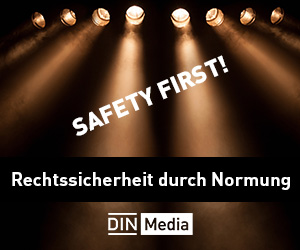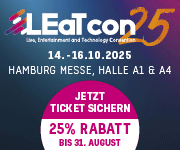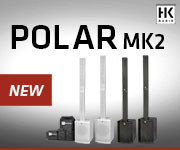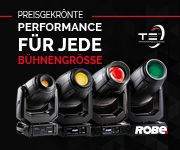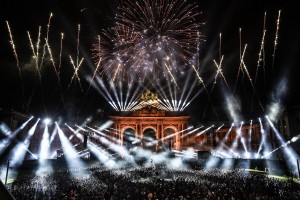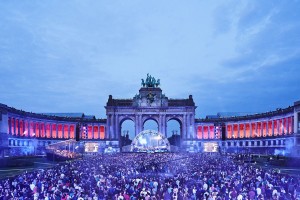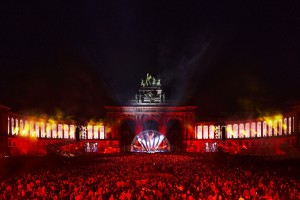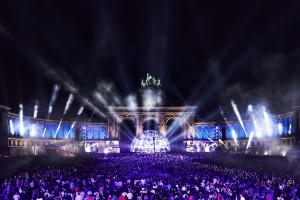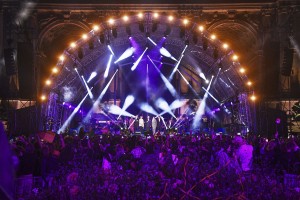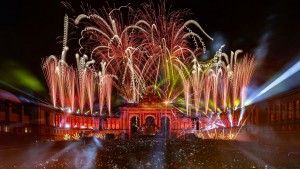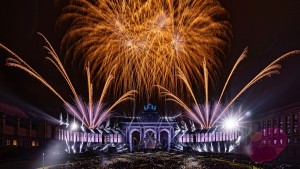Aktuelle News & Schlagzeilen
Painting with Light and More To Show busy at “Happy Belgium” event
Creative visual practice Painting with Light (PWL) was asked by the Agoria Sports and Entertainment Technology club, a networking hub for Belgian technology leaders, to show direct and design lighting for a mixed media visual spectacle - lighting, lasers and fireworks - which was the finale segment of the official 2023 Belgian National Day celebrations.
This year, the occasion also coincided with the tenth anniversary of the coronation of King Philippe of Belgium. The overall event which included a two-hour music festival, was titled “Happy Belgium”. The 15-minute Finale show was developed for the Syndicat d’Initiative-Bruxelles Promotion (SIBP) and staged against the backdrop of Cinquantenaire Arcade, a grand 30-metre-wide, 45-metre-high triple arched architectural monument in Brussels’ Parc du Cinquantenaire. It topped off the music festival event organised by the Prime Minister’s chancellery and was attended by 60,000 people as well as live broadcast across major networks.
The PWL team was led by the company’s founder and creative director Luc Peumans who collaborated closely with Patrick and Nathan Awouters, creative director and technical manager respectively from Agoria partner Laser System Europe (LSE), who provided the lighting equipment and forty lasers for the show. Pyro specialist Arteventia’s Edouard Grégoire designed and supplied the fireworks together with his team. The “Happy Belgium” finale was set to a special soundtrack composed by Patrick Awouters.
On the lighting side, a full set of IP rated fixtures was installed on and around the Cinquantenaire and the galleries and colonnades of its associated buildings, which curve away to the sides of the monolith. Fixtures comprised a mix of beams and washes and included sixty PR Lighting Aqua 580 Beams, eighteen Aqua 580 BWS, fifty Aqua LED 600 Spots, thirty FOS F7 strobe washes, ten Explo X2 Wave Flamers and fourteen hazers to assist with atmospherics, all of which were supplied by LSE.
In addition to these, Peumans tapped into eighteen of the music festival’s Chauvet ColorStrike M motorized strobe/wash fixtures that were part of the festival package and supplied by Splendit for DDMC, the event producers for that segment with their technical partner, production specialist More To Show.
Jordi Vandekerkhof from More To Show worked closely with Frank Anthierens and Nathalie Rasschaert from event agency Alice Events and DDMC Event Design. The festival featured performances by twelve Belgian artists accompanied by a 24-piece orchestra including rhythm section.
With the event design so intricately linked to the Cinquantenaire architecture, all the surrounding technical infrastructure - stage, lighting, PA arrays, delay towers, IMAG screens, etc. - was added with the goal of blending production seamlessly into the location, achieving a modern elegance and functionality in the historically significant setting.
Once Alice Events was awarded the pitch, it was time for More To Show to get involved and turn these plans into production realities. The scope of More To Show’s work included creating a lighting design for the buildings and the stage, managing all technical suppliers including audio, video, lighting, power, pyro and broadcasting and all other site infrastructure and necessities required for the main festival section with the specially arranged compositions co-ordinated by musical director Michel Bisceglia.
The Cinquantenaire, the inside and undersides of its arches, the exterior and interior walls as well as all the colonnades and supporting buildings were all lit in the plan, transforming its imposing presence and structural integrity into “natural” scenography.
“The key was to get exactly the right blend of technology and historic monument”, explains Vandekerkhof. Lighting the buildings brought the space alive with colour, texture, a sense of grandeur and a magical atmosphere, a task primarily achieved using a mix of Chauvet floods and moving lights all supplied, together with the D&B audio system, by rental company Splendit.
The eighteen Chauvet Color Strike M strobe/wash fixtures were placed inside the peristyles and functioned as an architectural wash for inside the buildings as well as doubling up for audience blinders, using the strobe and tilt function at strategic moments. Forty-eight Colorado Q40 LED Washes covered the building facades in light.
This was the first major event for Splendit’s 48 new Chauvet Maverick Storm Hybrid 1 IP65 beam/hybrid fixtures, some of which were placed on top of the arch and the buildings, with others on ground level along the front of the facade blasting out into the night sky. A third layer of lighting was created with more Storm Hybrid 1s lower down along the floor line, all adding more depth to the scene.
The stage, a 20-metre-wide dome stage from supplier Gigant International, was fitted with clear skins. It was chosen for its compact dimensions and because it would provide all the necessary weather protection for the orchestra and artists, whilst not affecting the visuality of the epic architecture behind.
More To Show’s stage lighting design had most overhead fixtures onstage rigged on a series of different length D-drops clamped to numerous points in the roof, a plan that accentuated the curvature of the roof and juxtaposed against the perpendicular lines of the Cinquantenaire. “Straight trusses simply would not have worked in this context, it was really important to preserve the splendour of the buildings as the backdrop”, notes Vandekerkhof.
Twenty-eight Chauvet MK3 Profile CXs were the primary stage side and key lights, with fifty-six Maverick Storm 2 Beam wash luminaires for additional TV light and fourteen Chauvet Ovation 1 Cyc fixtures used as footlights. Robe MegaPointes provided back lighting and aerial effects behind the stage.
Chauvet Strike Array 4 Blinders were deployed on all the six delay towers, combined with PWR Ranger blinders curving around the front edge of the stage roof for audience illumination. Follow spotting utilised two Robe BMFL WashBeams rigged on the main left and right delay towers, both running on RoboSpot remote follow spot systems.
Two GrandMA3 consoles were used for lighting control, a full size for the show lighting, operated by More To Show’s Cedric Duré and a GrandMA3 light for the key lights and TV specials, operated by Niels Huybrechts, also from More To Show.
The streamlined PA arrays were D&B J-series and live sound was mixed using a DiGiCo console by Frank Voet of Mono. IMAG was important not just so the large crowd could get a decent overview of the stage action, but also so they could appreciate screen-based elements like the ten video testimonials (one for each year of the King’s reign) from a selection of people who had overcome challenges in the quest to realise extraordinary achievements. Six 28 square metre LED screens were positioned around the site allowing views of the broadcast mix.
As for PWL’s job in preparation of the “Happy Belgium” event, the galvanizing part was to integrate the three distinctive visual elements into a fluid narrative collage, once the soundtrack was finalized. Much of the magic happened in a Syncronorm Depence previz suite as they visualized the show, critical to its success as in reality they had precious little situ time for programming on site.
A run through on the first evening was without pyro but produced plenty of notes, all of which had to be addressed and solved by the next day in PWL’s pre-vis suite onsite, with a further 1.5 hours the following night to review. To assist this process, a simulation of the fireworks was created by Arteventia that gave a realistic visual of the effects. The final show was fully timecoded and synched to the music track.
PWL’s lighting programmers were Tibo Spiessens and Jeroen Opsteyn using a GrandMA3 and the pre-programming was completed in Depence 3 in their visualization studio. The associate lighting designer was Sieben Vannuffelen, and the production Manager for LSE was Hans Cromheecke.
LSE’s lighting crew were Arnaud Favry, Jonathan Mulders, Fabian Fizaine, Jonathan Gault and Jules Roullet, and tec’ing the lasers were Thomas Avisse and Giovanni Laera. The lasers were designed and programmed by Patrick Awouters’ son Nathan, and LSE’s artistic consultant was Marcos Vinals.
Working alongside Edouard Grégoire on Team Arteventia was technical manager Gabriel Legrand, project manager Jean François Homerin and firers Anthony Poveda, Jordan Van Cappellen, Emmanuel Legrand, Amaury Vanderborght and Claudel Doucel.
The TV camera director for the festival and the finale/closing event was Hans Pannecoucke who had two close cams, one dolly, one crane, three handhelds, two PTZ remotes and a drone at his disposal to build the live and broadcast mix. Broadcast facilities were supplied by another Agoria partner, NEP Belgium, with Bart Thiron as a technical director.
Jordi Vandekerkhof’s More To Show production team on site also included Linne De Neef, co-ordinating site wide audio, video and lighting, and technical draftsperson Joost Rombaut.
The lighting crew chief was Cedriek Stoffels from Splendit, Tom Logghe was their audio crew chief, Karel Will was the sound technician and Julian Schelfhout the lighting tech, with the project overseen by Splendit’s owner, Marijn Broeckaert.
(Photos: Olivier Anbergen/Nathan Awouters/Frederic Lepla/Melting Prod/Nicolas Peeters)
SCHLAGZEILEN
news archiv
suche
© 1999 - 2025 Entertainment Technology Press Limited News Stories

